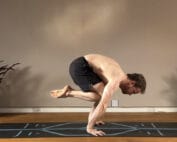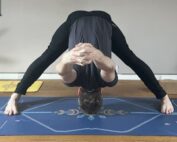
Mastering the Handstand: A Comprehensive Guide to Adho Mukha Vrksasana
Hi, I’m Dav Jones, yoga teacher and passionate guide in the art of inversions and arm balances. Today, we flip things upside down—literally—as we explore one of the most iconic and empowering postures in the yoga practice: the Handstand. More than just a party trick, this posture teaches strength, coordination, and embodied awareness. It’s a moment of flight where fear meets freedom, and where control is built through consistent, intelligent training.
What Is Handstand (Adho Mukha Vrksasana)?
The Handstand, or Adho Mukha Vrksasana (Downward-Facing Tree Pose), is an advanced inversion that challenges your body’s ability to stabilize under load while inverted. It requires precise neuromuscular coordination, dynamic shoulder girdle stability, and central core integration. Rooted in gymnastics and refined through the lens of yoga, this posture isn’t about brute force—it’s about managing ground reaction force, controlling center of mass, and maintaining fascial tension across your kinetic chains.
- Sanskrit Name: Adho Mukha Vrksasana
- Pronunciation: AH-doh MOO-kah vrik-SHAH-suh-nuh
- Meaning: Adho Mukha = downward-facing, Vrksa = tree. Like an upside-down tree, you ground through your hands and rise with strength and poise through the legs.
Physical and Mental Benefits of Handstands
Physical Benefits
- Strengthens the shoulder girdle and upper body: Co-contraction of scapular stabilizers (serratus anterior, lower trapezius, rotator cuff) and arm musculature creates a strong closed-chain support structure.
- Enhances dynamic balance: Improves interoception and proprioceptive feedback by training the central nervous system to track spatial orientation while inverted.
- Improves circulation and lymph flow: Inversions promote venous return and can regulate autonomic tone.
- Reinforces core integration: True core activation isn’t just abs—it includes transverse abdominis, pelvic floor, diaphragm, and multifidi, all coordinating to stabilize your spine under load.
- Fascial tensioning: The pose leverages the myofascial slings (especially the posterior and deep front lines) for support and rebound energy.
Mental Benefits
- Increases focus and cortical engagement: Handstand demands single-pointed concentration, which boosts the prefrontal cortex’s ability to stay on task.
- Overcomes fear and builds embodied confidence: Facing fear in inversion helps rewire your nervous system for resilience.
- Promotes calm through effort: Once balanced, your breath and mind find stillness, creating an inverted state of meditation.
Preparatory Poses for Handstand
These poses prep your body for Handstand by opening the shoulders, strengthening the core, and activating wrist and arm muscles:

POSE: Dolphin Pose
BENEFIT : Strengthens scapular stabilizers and mimics arm angle in handstand with less load

POSE: Plank Pose
BENEFITS: Develops anti-extension core strength and wrist conditioning

POSE: Downward Dog
BENEFIT : Enhances shoulder flexion and scapular upward rotation without compression

POSE: Forearm Plank
BENEFIT :Targets deep transverse core and improves endurance in anterior chain

POSE: Downward Dog Splits
BENEFIT :Teaches the L-Shaped Handstand shape without the added challenge of the balance

POSE: L-Shaped Handstand at the Wall
BENEFIT: Teaches axial loading and vertical line organization

POSE: Crane Pose (Bakasana)
BENEFIT: Introduces load-shifting through the wrists and teaches shoulder protraction for lift-off
Step-by-Step Guide to Handstand
1. Start in Downward Dog
Walk your feet slightly closer to your hands. Press into your metacarpal heads and fingertips—this is your foundation. Think “tripod tension”: heel of hand lifts subtly as fingertips engage.
2. Shift into Lunge Prep
Step one foot forward like you’re loading a spring. The rear leg becomes your driver—keep it extended and active, preparing to generate upward kinetic energy.
3. Engage Core + Pelvic Control
Draw the lower ribs in (thoracic compression control) and lift from the pelvic floor (mula bandha). Visualize your abdomen wrapping like a corset—360° engagement stabilizes your spine in neutral, not arching.
4. Kick Up (Float, Don’t Throw)
Bend the front knee and create a dynamic “push-pull”: press down firmly through your arms as your back leg floats up. Think of stacking hips over shoulders, not feet over hands. Use eccentric control from your hip flexors and core to stabilize the ascent.
5. Find Midline & Length
Squeeze inner thighs, point your toes, and extend through the balls of the feet. Press into the fingertips to adjust balance. Avoid over-gripping the floor—think rebound, not collapse.
6. Exit with Control
Lower one leg or cartwheel out with awareness. Finish in Child’s Pose to reset the nervous system or in Downward Dog to transition onward.
Modifications and Variations for Handstand
Beginners
- Wall-Supported Handstand: Face toward or away from the wall to explore alignment without fear of falling.
- L-Shape at Wall: Develops motor patterning for scapular protraction and spinal stacking.
- Use a Spotter: Helps regulate fear response and provides haptic feedback on alignment.
Intermediate
- Tuck Handstand: Requires deep core compression and posterior chain awareness.
- Straddle Handstand: Teaches leg independence and thoracic control under changing loads.
Advanced
- Press to Handstand: Pure control. Requires integrated strength across the anterior fascial sling and hip flexors.

- One-Legged Variations (Stag, Splits): Train balance recovery strategies and spinal segmentation awareness.
Common Mistakes in Handstands
- Overarching the Lower Back
Fix: Engage transverse abdominis and avoid anterior pelvic tilt. Think “ribs knit, tail draws down.” - Collapsing into Shoulders
Fix: Elevate the scapulae by activating serratus anterior. Push the floor away—your shoulders shouldn’t hang. - Kicking with Momentum
Fix: Use ground reaction force. Lift through muscle control and pressure—not ballistic energy. - Holding the Breath
Fix: Establish a consistent breath pattern, even if shallow. Breath connects brain and body in motion.
How to Incorporate Handstands into Your Practice
Handstands are best trained like skill-based strength: frequent, focused, and neurologically fresh.
- Frequency: 5–10 minutes daily is more effective than once-a-week sessions.
- Timing: Place earlier in practice when nervous system is alert, not fatigued.
- Integration: Use handstands as peak postures in strength or inversion-themed flows.
Final Thoughts
Handstand is a moving meditation and a journey of self-trust. It doesn’t matter how long you hold it—what matters is how consistently you show up to refine the process. Fall often, learn always. Inversions are the yoga of transformation: they literally flip your perspective.
If you’re ready to level up your inversion game, check out my Patreon channel for guided handstand drills, shoulder strengthening flows, and fear-reducing prep work. For 1-on-1 support, explore the DJY Mentorship program—tailored coaching to meet you exactly where you are.









